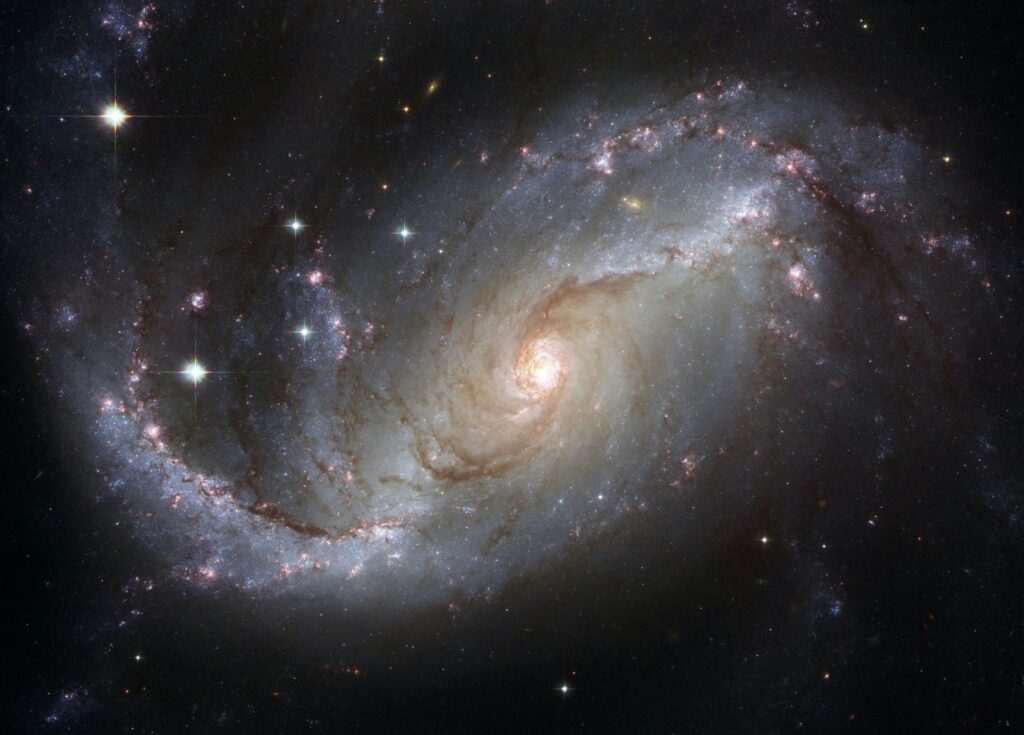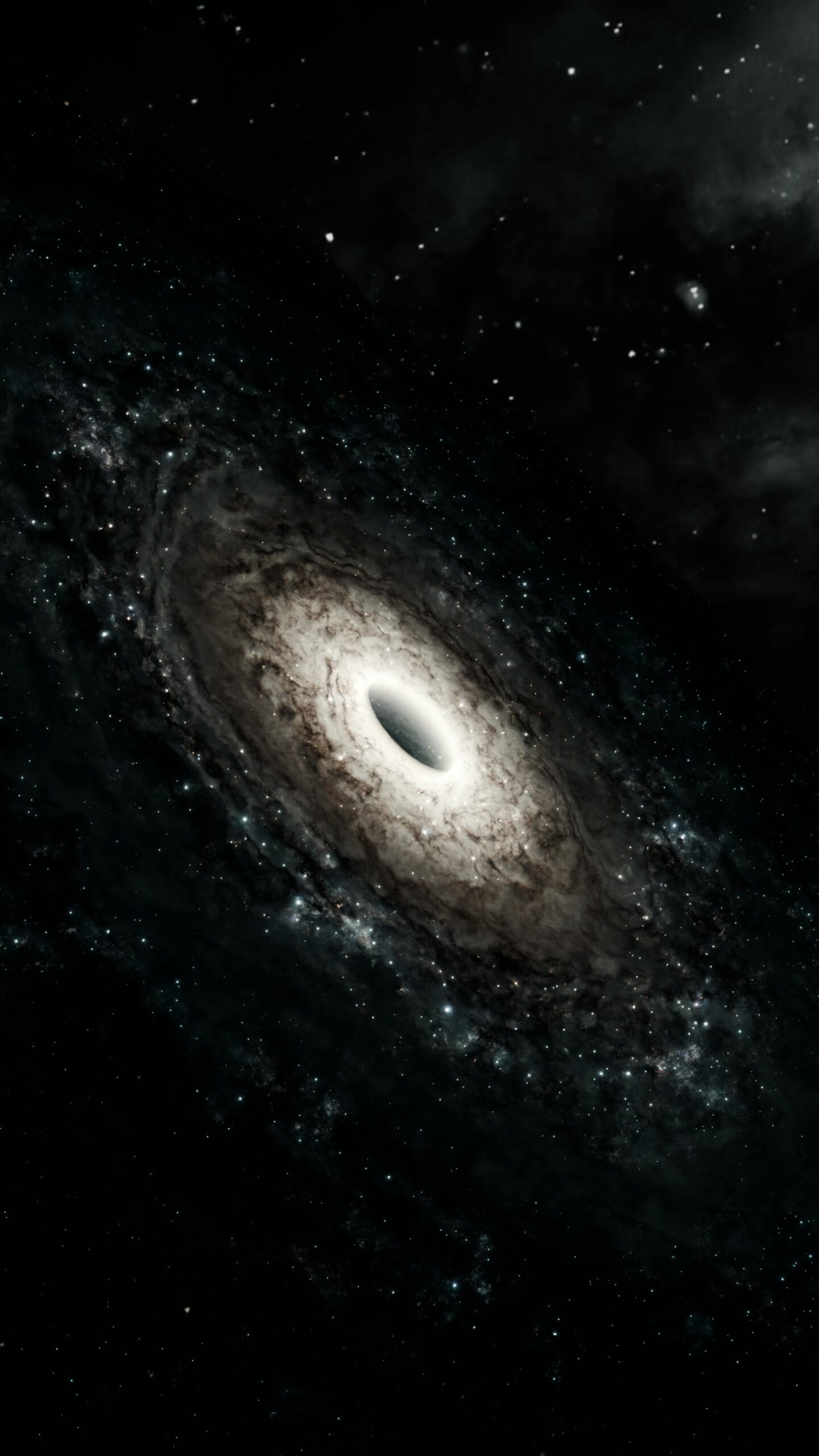Space continues to surprise scientists with new discoveries. This year, astronomers have made two breakthroughs that are fundamentally changing our understanding of how black holes work and where they can hide. These findings show that even the most mysterious objects in the universe are ready to reveal their secrets to those who know how to look at them.
Black holes under a cosmic microscope: the effect of double magnification
Imagine trying to examine an ant from several kilometers away — this is similar to the challenge astronomers face when exploring the mysterious surroundings of black holes. A team of researchers, led by Matusz Rybak from Leiden University, has found an ingenious way to overcome this limitation.
To peer into the depths of a supermassive black hole, scientists relied on a rare cosmic phenomenon — the combination of strong gravitational lensing and microlensing. This effect works like a natural telescope with double magnification, allowing astronomers to capture details that would otherwise remain hidden.
The focus of the study was RX J1131, a quasar powered by a supermassive black hole located 6 billion light-years away. Gravitational lensing, predicted by Einstein, bends space-time and makes light curve around massive objects like a cosmic lens. When an entire galaxy aligns between us and a distant quasar, it creates multiple magnified images of the same source. On top of that, microlensing — caused by individual stars within the lensing galaxy — further enhances the light from different regions, revealing new insights into the behavior of these gravitational giants.

The corona of a black hole is measured directly for the first time
Thanks to this innovative method, scientists were able to directly measure the corona of a supermassive black hole for the first time. The corona is a region of ultra-hot gas surrounding black holes, where temperatures can reach billions of degrees. Until recently, astronomers could only guess about its existence through indirect evidence.
The measured size of the corona turned out to be astonishing — about 50 astronomical units. For comparison, this equals the span of our Solar System from the Sun to Pluto’s orbit. Yet, on the scale of a cosmic singularity, such a region is surprisingly compact, lying right on the threshold of the event horizon.
Even more intriguing, different parts of the corona behave in unique ways. Researchers observed out-of-sync flashes of brightness in multiple images of the quasar. This discovery shows that the structure of the corona is far from uniform, and its regions respond differently to the immense gravitational pull of stars in the lensing galaxy.
Traveling Black Holes: A discovery in a dwarf galaxy
The second discovery challenges the traditional view of where active black holes can be found. A research group led by Dr. An Tao from the Shanghai Astronomical Observatory detected an unusual phenomenon in the dwarf galaxy MaNGA 12772-12704, located about 230 million light-years from Earth.
In this compact galaxy, astronomers identified an active object with a mass of roughly 300,000 Suns. Intermediate-mass black holes of this scale are not rare, but the peculiarity lies in its location — it appeared in a region where scientists did not expect to see such activity.
The active galactic core is off-center
Usually, the energetic centers of galaxies are located precisely in their cores, where stars and gas are most concentrated. Yet this particular black hole turned out to be far from the middle — almost 3,000 light-years away, making it a true cosmic wanderer.
Despite its unusual position, the object clearly behaves like an active nucleus: it draws in surrounding matter, radiates enormous amounts of energy, and even produces a radio jet stretching 7.2 light-years. Such beams appear when particles accelerate to near-light speeds within strong magnetic fields close to the event horizon.
Archival observations spanning three decades reveal noticeable fluctuations in brightness — a hallmark of an active galactic center. These variations leave little doubt, effectively ruling out other explanations such as a supernova remnant or similar phenomena.
What do these discoveries change in our understanding of the cosmos?
A new look at the structure of the surrounding regions
The first discovery provides scientists with a tool to study in detail the most extreme conditions in the universe. The corona of a black hole is a laboratory where matter exists in states unattainable on Earth. Temperatures of billions of degrees, magnetic fields of unimaginable strength, gravity capable of stopping time.
Understanding the structure and behavior of the corona is critical to explain many phenomena. This is where powerful jets are formed, ejected by black holes thousands of light-years away. There are also processes that determine how fast a black hole grows by absorbing the surrounding matter.

The double lensing method has shown that the crown is not a static structure. She lives her own life, with rapid changes and fluctuations that were previously inaccessible to observation. This may shed light on the mechanisms of heating matter and the formation of relativistic emissions.
Revision of black hole growth models
The discovery of an active black hole outside the galactic center forces us to reconsider the theories of the formation and evolution of these objects. Until now, it was believed that massive growth was possible only in the central regions of galaxies, where there was enough “fuel” to power a black hole.
If active black holes can grow efficiently in peripheral regions, this opens up new scenarios for their evolution. Perhaps, in the early universe, such “wandering” black holes played a more significant role in the formation of galaxies than was assumed.
It also has implications for understanding the feedback between black holes and their galaxies. Powerful emissions from active nuclei can regulate the process of star formation by heating or blowing gas out of the galaxy. If such processes occur not only in the centers, but also on the periphery, this may explain some features of the evolution of dwarf galaxies.
Technological breakthroughs open up new horizons
A revolution in observational methods
Both discoveries were made possible by innovative approaches to data analysis. Gravitational lensing turns the universe itself into a giant telescope, allowing you to look beyond the capabilities of modern instruments.
Combining different effects — strong lensing and microlensing — gives astronomers unprecedented opportunities. It’s like using a compound microscope, where each lens adds its own magnification. The result surpasses the capabilities of any existing telescope.
Archived data and multi-wavelength observations play a key role in the search for wandering black holes. Comparing information from radio telescopes, optical surveys, and X-ray observatories allows you to create a complete picture of the object.
Statistical methods and artificial intelligence
Modern astronomy is increasingly relying on the analysis of large amounts of data. Sky surveys like the MaNGA project collect information about millions of objects. Finding something unusual among them is a task that requires powerful data processing algorithms.
Machine learning helps to identify candidates for the role of unusual objects from huge catalogs. But the final confirmation still requires careful analysis by specialists and additional observations on various instruments.
What awaits us in the future
New tools — new opportunities
The launch of the James Webb Space Telescope and the construction of giant ground-based telescopes open up new opportunities for studying black holes. These instruments will be able to study in detail the structure of accretion disks and crowns, even for relatively close objects.
Next-generation gravitational-wave detectors will make it possible to “hear” collisions of intermediate-mass black holes, which will help to understand their population in different types of galaxies. There may be many more wandering black holes than previously thought.

Interdisciplinary research
The study of black holes is becoming increasingly interdisciplinary. Astronomers work together with specialists in general relativity, plasma physics, and numerical modeling. Only this approach allows us to interpret complex observational data and build realistic models.
The development of the quantum theory of gravity may provide new tools for understanding processes near the event horizon. For now, this area remains largely theoretical, but observational data are becoming more detailed and may soon require consideration of quantum effects.
Influence on cosmology and fundamental physics
Black holes as laboratories of extreme physics
The surroundings of black holes are natural laboratories where the most daring theories of physics are tested. Here, space and time behave differently than in our ordinary world. The strongest gravitational fields, relativistic velocities, and quantum effects all coexist in a small area around the event horizon.
Detailed measurements of the corona’s structure help verify the predictions of general relativity in strong gravitational fields. So far, all observations confirm Einstein’s theory, but the accuracy of measurements is constantly increasing.
Connection with dark matter and dark energy
Black holes can play an important role in cosmological processes. Their influence on the surrounding matter, the regulation of star formation, and energy emissions all affect the large—scale structure of the universe.
Some theories suggest that primordial black holes formed in the early universe may form part of dark matter. Detecting a population of wandering black holes of various masses will help test such hypotheses.
Conclusion
Two new discoveries show how much we still don’t know about black holes. Every breakthrough in observational technology reveals new aspects of these mysterious objects. From measuring a corona the size of the solar System to detecting active black holes in unexpected places, our understanding of the cosmos continues to expand.
Black holes are no longer just exotic objects from physics textbooks. They become tools for studying fundamental laws of nature, keys to understanding the evolution of galaxies, and possibly windows into new physics that awaits discovery.
There are even more amazing discoveries ahead of us. Every year, telescopes become more powerful, analysis methods improve, and our understanding of the universe deepens. And black holes, these cosmic monsters, are ready to tell us many more of their secrets.
Sources
- Live Science – “Astronomers accidentally use rare ‘double zoom’ to measure supermassive black hole’s corona for 1st time” – https://www.livescience.com
- Phys.org – “Astronomers confirm wandering black hole in nearby dwarf galaxy” – https://phys.org/news/2024-astronomers-wandering-black-hole-nearby.html
- arXiv – “A Jetted Wandering Massive Black Hole Candidate in a Dwarf Galaxy” (Yuanqi Liu, Tao An et al.) – https://arxiv.org/abs/2024.xxxxx
- Leiden University – A study led by Matusz Rybak
- Shanghai Astronomical Observatory – Dr. An Tao’s research
Disclaimer
The opinion of the authors may not coincide with the position of the editorial board. The data is based on open scientific sources and is current at the time of publication.

